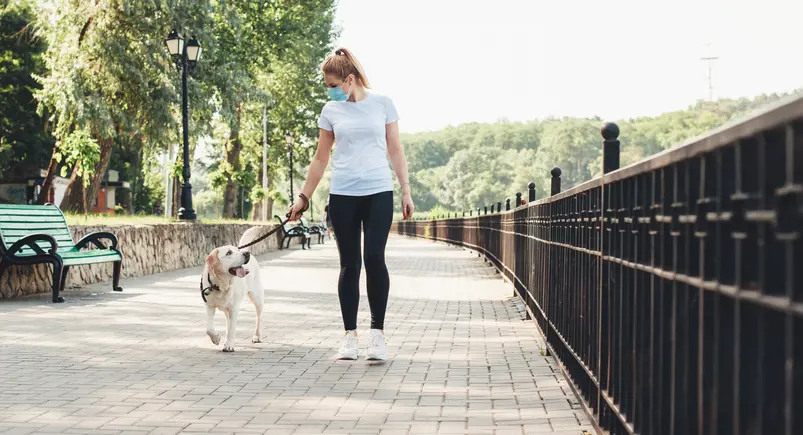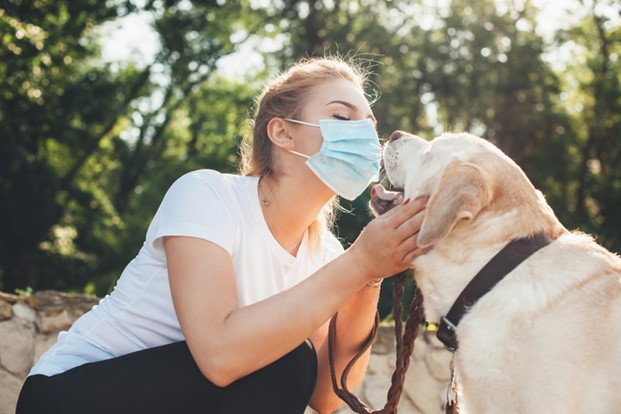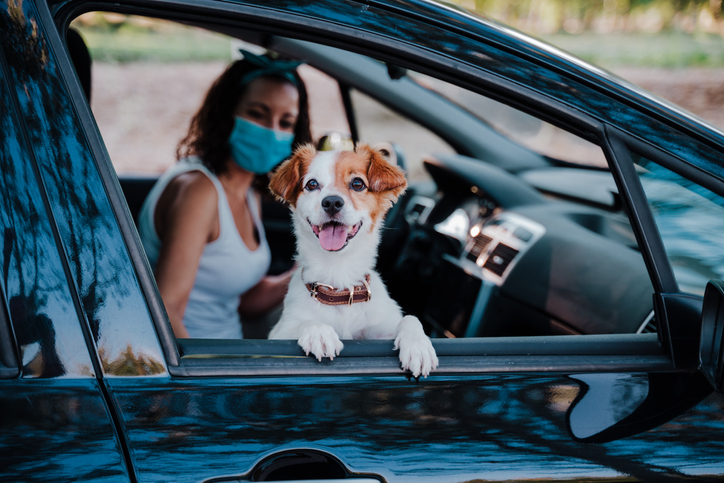How to get your dog used to people wearing face masks
9th August, 2021

Many dogs are creatures of habit: give them a warm basket and a walk each day, and they’re happy. Show them something new, however, and it can take them a while to adjust.
So the sight and sound of people wearing face masks can be an alarming one for your poor pooch. As the UK eases its way out of lockdown, responsible dog owners need to find ways to help their pets cope with this unsettling situation.
At Purely Pets, we help protect your pets through our award-winning cat and dog insurance. Now, we’ve drawn on our pet expertise to put together a seven-step plan for getting your mutt used to people wearing face masks.

What is the issue with dogs and masks?
It’s tempting to think that dogs are unbothered by what goes on in the human world. After all, a global pandemic means absolutely nothing to your precious pet!
But dogs can be surprisingly sensitive to changes in the human environment, and they pick up on all sorts of tiny cues that we might not spot. As they don’t always understand what these changes mean, they can be alarmed by them.
Humans wearing face masks is a source of bewilderment to your average mutt: they don’t get why people are suddenly covering their mouth and noses. If their pack leader, i.e. you, is doing something different, that’s hugely unnerving for your average mutt.
Worse, face masks stop dogs reading our faces properly. Your pooch finds it harder to tell whether you’re angry or pleased with its behaviour, so isn’t sure how to react.
And masks might muffle our voices, too, confusing your poor pet even further. It might not recognise your voice when you call it, or could be uncertain what you mean as it can’t hear the sounds or interpret your tone correctly. For a dog who just wants to please its master, that’s a very disturbing situation to be in.
All in all, the experience of humans in masks can be anxiety-inducing for a timid pup. But masks are due to be with us for some time to come, on and off, so it’s your job as owner to help your pet face its fears and relax.
How do dogs show anxiety?
Dogs can’t tell you in words that they’re anxious. But most owners are attuned to their pets’ habits and behaviours, and can tell when something’s up.
Subtle signs that your dog is anxious include licking its lips, lifting a paw, or looking away. If you spot these early signs while following our plan below to introduce your dog to face masks, then you know it’s time to take a breather.
More overt signs of an anxious or confused canine are cowering, whimpering, panting, pacing or shivering. It could even try to run away or dig a hole to hide in. Some dogs even chew or hurt themselves when frightened, though this would be an extreme reaction.
If your dog feels actively threatened by the sight of a human in a mask, it may act defensively. That could mean barking and growling, or even snarling and baring its teeth. You need to take immediate action at this point to remove the dog from the situation and give it space to calm down.
If you’re taking your dog for a walk, the sight of lots of people wearing face masks could be truly alarming for your animal and might trigger its flight or fight instinct.
Dog insurance can provide cover for third party liability, or for the costs associated with reuniting you with your lost pet, but this is obviously a situation you want to avoid.
Getting your dog used to masks
As always with dog training, the key to overcoming your dog’s distrust of face masks is to introduce things as slowly as necessary.
Pick a time when you and your pet are both relaxed, and offer plenty of reassurance and praise throughout the process. Tasty treats to reward obedience or calm behaviour will help, too!
We’ve put together a seven-step approach, based on advice from the experts at the PDSA and Battersea Dogs and Cats Home charities, that we believe will help your dog get used to the new normal.
Of course, if your dog adjusts quickly, you might be able to rush through a few of these steps, or skip them altogether. Play it by ear – you know your pet best!
However, if the process turns into a real struggle, you could seek expert advice. With dog insurance from Purely Pets, you get access to a 24-hour vet helpline for all your canine concerns.
Step 1: Show your dog the mask
Pick up the mask, and show it to your dog. Don’t thrust it at your dog’s nose – let your pet approach in its own time and have a good sniff!
If it seems comfortable, try issuing a command it already knows, such as ‘sit’ or ‘stay’. If your dog obeys, then it is happy to listen to you while you are holding a mask, and you can move onto the next step.
If it seems bothered by the mask, place it on the floor a short distance away from you. Then give your dog lots of attention, by playing with it or stroking it. Hopefully, your animal will start to relax, even with the mask present.
If so, pick up the mask again and see if your dog will approach for a sniff.
With some animals, this step can take a while. Try not to rush your dog: you risk making the situation worse. If your pet seems very agitated, remove the mask from the scene and try again another time.
Step 2: Use your hand to cover your face
Now it’s time to get your animal used to the experience of seeing your face covered. Place your hand in front of your mouth, and give your dog lots of attention. Reward it with a treat, too.
If it seems happy, try issuing a command it knows. This helps it get used to the sound of your voice when it’s muffled. Once it’s obeyed your command, you’re ready to move onto the next stage.
Step 3: Gradually place the mask on your face
This might well be the stage which alarms your pooch the most, so take it extra slowly.
First, hold up the mask to your face for a few seconds. Don’t put it on – just rest it loosely in position and let your dog see. Give it a treat at the same time.
Once your dog seems comfortable with this, hold the mask to your face and issue a command. If your dog obeys, reward it with a treat and praise.
Some pooches might be perfectly happy at this point, so you can try putting the mask on properly and repeating the treats and commands.
However, many dogs may still be wary. So a more gradual approach is to try putting the mask on so it covers just a small portion of your face: your chin, your nose or your mouth. Work up to full coverage.
Eventually, your dog should be responding to you normally when you’re wearing the face mask in its proper position. Time to move onto the next step!
Step 4: Everyday mask wearing
Hopefully, your pup is now accustomed to you wearing your face mask. Check by putting it on at random times as you go about your daily business.
Soon, your dog should come to regard your face mask as just another weird yet harmless thing that humans do, along with eating at a table and refusing to chase your own tail.

Step 5: Introduce other people your dog knows wearing face masks
So your pooch has now established that you, its pack leader, have a strange quirk that’s nothing for a humble hound to worry about. But how will it react to others following suit?
This step is key, as it will help your dog adjust to exploring the world outside your home.
Ask another person known to your dog, ideally an adult in your family, to enter the room wearing a mask without approaching the dog directly.
If your dog greets the new person and remains calm, it deserves a treat. Once it’s totally relaxed, the other mask-wearing adult can approach your pet and interact directly.
However, if your dog shows signs that it is bothered, then give it lots of reassurance. Your human accomplice could try putting on the mask gradually, as in Step 2 above, or you could take a break and try Step 5 again later.
Step 6: Head outside
It’s now time for a trial run. If it’s taken you a while to get through the first five stages with your anxious pup, rest assured: you’ve nearly made it!
Take your dog outside, perhaps into your garden or a quiet corner of a park your dog knows well.
Run through the first few steps again: showing the mask in your hand, placing it on your face, and wearing it properly. Remember to reward your pooch for calm behaviour.
When you’re satisfied your pet is relaxed and happy, get the other person your dog knows well to approach while wearing a mask. The mask wearer should stop some distance away, give your dog time to adjust, then come a bit closer.
If your dog stays calm throughout, and the mask wearer is able to approach without any signs of fear or aggression from your pup, then congratulations! You’re ready for the final push.
Step 7: The real test!
Your pooch is now ready for the final hurdle: being out in public surrounded by people in face masks.
Start with a trip to a park at a quiet time of day. Keep your first trip quick, and make the most of social distancing to give your dog plenty of space.
Keep it on the lead at first. An anxious dog might react to the sight of strangers in face masks with alarm, perhaps even scarpering in double quick time. Dog insurance can include cover for the costs of reuniting you with your fearful pet, but it’s certainly easier and less traumatic to avoid the problem as best you can.
Hopefully, however, your dog will stay calm while passing a stranger wearing a face mask. Remember to reward it with praise and a treat.
Build up gradually over the course of a few days, until you’re confident your pet has become blasé about the experience. Then you can try out busier environments, such as high streets or parks on sunny weekends.
Of course, if your dog shows any sign of anxiety or upset, you should backtrack a little. Take your pet to a quiet corner or back home, and give it lots of cuddles and reassurance.
But with any luck, your pooch is now content with the sight of humans in face masks. After all, it’s used to you doing all sorts of things considered weird in the canine world: wearing clothes, for example, or refusing to touch a ball covered in drool. Fortunately, it thinks you’re fantastic just the way you are.
Get a quote for dog insurance from Purely Pets
Dogs have been our constant companions throughout lockdown, bringing us joy in some very tough times. Now they’re by our sides as we adapt to the new normal, too.
At Purely Pets, we know just how important dogs are to their owners’ lives. So we want to help you protect your precious pets, by offering a range of lifetime dog insurance policies to suit your animal, your requirements and your budget.
Cover benefits include vets’ fees of up to £15,000, depending on the policy you choose, with an excess starting from just £60. Cover is also available for third party liability, special diets, complementary treatment, loss by theft or straying, and much more.
With a 24-Hour Vet Helpline and online customer policy management, we make it easy for you to access support at any time.
Policy benefits, features and discounts offered may very between insurance schemes or cover selected and are subject to underwriting criteria. Information contained within this article is accurate at the time of publishing but may be subject to change.
Helpful Pages
Recent Posts
Pet Insurance Quote
- 98% claims paid *
- Claims paid directly to vets
- 24/7 vet video consultations
- Interest free monthly payments




